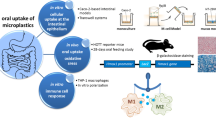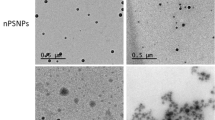Abstract
The plausibility of human exposure to microplastics has increased within the last years. Microplastics have been found in different food types including seafood, salt, sugar and beverages. So far, human health effects of microplastics after ingestion are unknown. Herein, we designed a novel, three-dimensional in vitro intestinal model consisting of the human intestinal epithelial cell lines Caco-2 and HT29-MTX-E12 as well as human blood monocyte-derived macrophages and dendritic cells that is suitable to assess the possible effects of ingested microplastics. Relevant microplastic particles (in the order of 50–500 µm), including polymers representing tire wear and polyolefins, which represent major sources of microplastic in the EU, were compared to other polymer classes and an inorganic microparticle, healing earth, which is intended for human consumption. Microplastic particles were exposed at concentrations of 823.5–1380.0 µg/cm2 to the model using a dry powder insufflator system to aerosolize the particles directly on the intestinal model’s surface. Cytotoxicity was investigated after 6, 24 and 48 h of exposure via measuring the release of lactate dehydrogenase. Inflammatory end points including the cytokines IL-8, TNFα and IL-1β as well as changes of the barrier integrity after exposure were additionally monitored. We demonstrated that all of the microplastics and the healing earth particles did not cause any significant cytotoxicity or release of (pro-)inflammatory cytokines and did not change the barrier integrity of the co-culture at any of the time points investigated.









Similar content being viewed by others
References
Allen S, Allen D, Phoenix VR, Le Roux G (2019) Atmospheric transport and deposition of microplastics in a remote mountain catchment. Nat Geosci 12:339–344
Amorim MJB, Lin S, Schlich K et al (2018) Environmental impacts by fragments released from nanoenabled products: a multiassay, multimaterial exploration by the SUN approach. Environ Sci Technol 52:1514–1524. https://doi.org/10.1021/acs.est.7b04122
Antunes F, Andrade F, Araújo F et al (2013) Establishment of a triple co-culture in vitro cell models to study intestinal absorption of peptide drugs. Eur J Pharm Biopharm 83:427–435. https://doi.org/10.1016/j.ejpb.2012.10.003
Araújo F, Sarmento B (2013) Towards the characterization of an in vitro triple co-culture intestine cell model for permeability studies. Int J Pharm 458:128–134. https://doi.org/10.1016/j.ijpharm.2013.10.003
Béduneau A, Tempesta C, Fimbel S et al (2014) A tunable Caco-2/HT29-MTX co-culture model mimicking variable permeabilities of the human intestine obtained by an original seeding procedure. Eur J Pharm Biopharm 87:290–298. https://doi.org/10.1016/j.ejpb.2014.03.017
Bouwmeester H, Hollman PCH, Peters RJB (2015) Potential health impact of environmentally released micro- and nanoplastics in the human food production chain: experiences from nanotoxicology. Environ Sci Technol 49:8932–8947. https://doi.org/10.1021/acs.est.5b01090
Calatayud M, Vázquez M, Devesa V, Vélez D (2012) In vitro study of intestinal transport of inorganic and methylated arsenic species by Caco-2/HT29-MTX cocultures. Chem Res Toxicol 25:2654–2662. https://doi.org/10.1021/tx300295n
Chen PC, Mead EH, Pinto JG, Colwell CW (1995) Polyethylene wear debris in modular acetabular prostheses. Clin Orthop Relat Res 20:44–56
Cole M, Lindeque P, Halsband C, Galloway TS (2011) Microplastics as contaminants in the marine environment: a review. Mar Pollut Bull 62:2588–2597. https://doi.org/10.1016/j.marpolbul.2011.09.025
ECHA (2019). https://echa.europa.eu/de/-/echa-proposes-to-restrict-intentionally-added-microplastics
Edmondson R, Broglie JJ, Adcock AF, Yang L (2014) Three-dimensional cell culture systems and their applications in drug discovery and cell-based biosensors. Assay Drug Dev Technol 12:207–218. https://doi.org/10.1089/adt.2014.573
Eubeler JP, Bernhard M, Knepper TP (2010) Environmental biodegradation of synthetic polymers II. Biodegradation of different polymer groups. Trends Anal Chem 29:84–100. https://doi.org/10.1016/j.trac.2009.09.005
Fendall LS, Sewell MA (2009) Contributing to marine pollution by washing your face: microplastics in facial cleansers. Mar Pollut Bull 58:1225–1228. https://doi.org/10.1016/j.marpolbul.2009.04.025
Hallab NJ, McAllister K, Brady M, Jarman-Smith M (2012) Macrophage reactivity to different polymers demonstrates particle size- and material-specific reactivity: PEEK-OPTIMA(®) particles versus UHMWPE particles in the submicron, micron, and 10 micron size ranges. J Biomed Mater Res Part B Appl Biomater 100:480–492. https://doi.org/10.1002/jbm.b.31974
Hilgendorf C, Spahn-Langguth H, Regårdh CG et al (2000) Caco-2 versus Caco-2/HT29-MTX co-cultured cell lines: permeabilities via diffusion, inside- and outside-directed carrier-mediated transport. J Pharm Sci 89:63–75. https://doi.org/10.1002/(SICI)1520-6017(200001)89:1%3c63:AID-JPS7%3e3.0.CO;2-6
Iñiguez ME, Conesa JA, Fullana A (2017) Microplastics in Spanish table salt. Sci Rep 7:8620. https://doi.org/10.1038/s41598-017-09128-x
Jin Y, Lu L, Tu W et al (2019) Impacts of polystyrene microplastic on the gut barrier, microbiota and metabolism of mice. Sci Total Environ 649:308–317. https://doi.org/10.1016/j.scitotenv.2018.08.353
Kämpfer AAM, Urbán P, Gioria S et al (2017) Development of an in vitro co-culture model to mimic the human intestine in healthy and diseased state. Toxicol In Vitro 45:31–43. https://doi.org/10.1016/j.tiv.2017.08.011
Kim SK (1968) Small intestine transit time in the normal small bowel study. Am J Roentgenol Radium Ther Nucl Med 104:522–524
Kole PJ, Lohr AJ, Van Belleghem FGAJ, Ragas AMJ (2017) Wear and tear of tyres: a stealthy source of microplastics in the environment. Int J Environ Res Public Health 14:1265. https://doi.org/10.3390/ijerph14101265
Kosuth M, Mason SA, Wattenberg EV (2018) Anthropogenic contamination of tap water, beer, and sea salt. PLoS ONE 13:e0194970. https://doi.org/10.1371/journal.pone.0194970
Lee J, Cuddihy MJ, Kotov NA (2008) Three-dimensional cell culture matrices: state of the art. Tissue Eng Part B Rev 14:61–86. https://doi.org/10.1089/teb.2007.0150
Lehmann AD, Daum N, Bur M et al (2011) An in vitro triple cell co-culture model with primary cells mimicking the human alveolar epithelial barrier. Eur J Pharm Biopharm 77:398–406. https://doi.org/10.1016/j.ejpb.2010.10.014
Leonard F, Collnot E-M, Lehr C-M (2010) A three-dimensional coculture of enterocytes, monocytes and dendritic cells to model inflamed intestinal mucosa in vitro. Mol Pharm 7:2103–2119. https://doi.org/10.1021/mp1000795
Li J, Yang D, Li L et al (2015) Microplastics in commercial bivalves from China. Environ Pollut 207:190–195. https://doi.org/10.1016/j.envpol.2015.09.018
Liebezeit G, Liebezeit E (2013) Non-pollen particulates in honey and sugar. Food Addit Contam Part A Chem Anal Control Expo Risk Assess 30:2136–2140. https://doi.org/10.1080/19440049.2013.843025
Liebezeit G, Liebezeit E (2014) Synthetic particles as contaminants in German beers. Food Addit Contam Part A Chem Anal Control Expo Risk Assess 31:1574–1578. https://doi.org/10.1080/19440049.2014.945099
Mabbott NA, Donaldson DS, Ohno H et al (2013) Microfold (M) cells: important immunosurveillance posts in the intestinal epithelium. Mucosal Immunol 6:666–677. https://doi.org/10.1038/mi.2013.30
Mahler GJ, Esch MB, Tako E et al (2012) Oral exposure to polystyrene nanoparticles affects iron absorption. Nat Nanotechnol 7:264–271. https://doi.org/10.1038/nnano.2012.3
Mason SA, Welch VG, Neratko J (2018) Synthetic polymer contamination in bottled water. Front Chem 6:10377. https://doi.org/10.3389/fchem.2018.00407
Mattar AF, Teitelbaum DH, Drongowski RA et al (2002) Probiotics up-regulate MUC-2 mucin gene expression in a Caco-2 cell-culture model. Pediatr Surg Int 18:586–590. https://doi.org/10.1007/s00383-002-0855-7
Navabi N, McGuckin MA, Lindén SK (2013) Gastrointestinal cell lines form polarized epithelia with an adherent mucus layer when cultured in semi-wet interfaces with mechanical stimulation. PLoS ONE 8:e68761. https://doi.org/10.1371/journal.pone.0068761
Neubauer N, Scifo L, Navratilova J et al (2017) Nanoscale coloristic pigments: upper limits on releases from pigmented plastic during environmental aging, in food contact, and by leaching. Environ Sci Technol 51:11669–11680. https://doi.org/10.1021/acs.est.7b02578
Nowack B, Boldrin A, Caballero A et al (2016) Meeting the needs for released nanomaterials required for further testing—the SUN approach. Environ Sci Technol 50:2747–2753. https://doi.org/10.1021/acs.est.5b04472
Pinto M, Robineleon S, Appay MD et al (1983) Enterocyte-like differentiation and polarization of the human-colon carcinoma cell-line Caco-2 in culture. Biol Cell 47:323–330
Plastic Europe (2018) Plastics – the Facts 2017. PlasticEurope 1–44.
Prata JC (2018) Airborne microplastics: consequences to human health? Environ Pollut 234:115–126. https://doi.org/10.1016/j.envpol.2017.11.043
Rescigno M, Borrow P (2001) The host-pathogen interaction: new themes from dendritic cell biology. Cell 106:267–270
Rezania S, Park J, Md Din MF et al (2018) Microplastics pollution in different aquatic environments and biota: a review of recent studies. Mar Pollut Bull 133:191–208. https://doi.org/10.1016/j.marpolbul.2018.05.022
Rimoldi M, Chieppa M, Larghi P et al (2005) Monocyte-derived dendritic cells activated by bacteria or by bacteria-stimulated epithelial cells are functionally different. Blood 106:2818–2826. https://doi.org/10.1182/blood-2004-11-4321
Rochman CM, Tahir A, Williams SL et al (2015) Anthropogenic debris in seafood: plastic debris and fibers from textiles in fish and bivalves sold for human consumption. Sci Rep 5:14340. https://doi.org/10.1038/srep14340
Ryan PG, Moore CJ, van Franeker JA, Moloney CL (2009) Monitoring the abundance of plastic debris in the marine environment. Philos Trans R Soc Lond B Biol Sci 364:1999–2012. https://doi.org/10.1098/rstb.2008.0207
Schimpel C, Teubl B, Absenger M et al (2014) Development of an advanced intestinal in vitro triple culture permeability model to study transport of nanoparticles. Mol Pharm 11:808–818. https://doi.org/10.1021/mp400507g
Scott-Fordsmand JJ, Navas JM, Hund-Rinke K et al (2017) Nanomaterials to microplastics: Swings and roundabouts. Nano Today 17:7–10. https://doi.org/10.1016/j.nantod.2017.09.002
Steffens KJ (1995) Persorption—criticism and agreement as based upon in vitro and in vivo studies on mammals. Absorption of orally administered enzymes. Springer, Berlin
Susewind J, de Souza C-W, Repnik U et al (2016) A 3D co-culture of three human cell lines to model the inflamed intestinal mucosa for safety testing of nanomaterials. Nanotoxicology 10:53–62. https://doi.org/10.3109/17435390.2015.1008065
Van Cauwenberghe L, Janssen CR (2014) Microplastics in bivalves cultured for human consumption. Environ Pollut 193:65–70. https://doi.org/10.1016/j.envpol.2014.06.010
Walter E, Janich S, Roessler BJ et al (1996) HT29-MTX/Caco-2 cocultures as an in vitro model for the intestinal epithelium: in vitro-in vivo correlation with permeability data from rats and humans. J Pharm Sci 85:1070–1076. https://doi.org/10.1021/js960110x
Wohlleben W, Meyer J, Muller J et al (2016) Release from nanomaterials during their use phase: combined mechanical and chemical stresses applied to simple and multi-filler nanocomposites mimicking wear of nano-reinforced tires. Environ Sci Nano 3:1036–1051. https://doi.org/10.1039/C6EN00094K
World Health Organization (2019) Microplastics in drinking-water
Wright SL, Kelly FJ (2017) Plastic and human health: a micro issue? Environ Sci Technol 51:6634–6647. https://doi.org/10.1021/acs.est.7b00423
Wu WM, Yang J (2017) Microplastics pollution and reduction strategies. Criddle Front Environ Sci. https://doi.org/10.1007/s11783-017-0897-7
Yousif E, Haddad R (2013) Photodegradation and photostabilization of polymers, especially polystyrene: review. Springerplus 2:398. https://doi.org/10.1186/2193-1801-2-398
Zietarska M, Maugard CM, Filali-Mouhim A et al (2007) Molecular description of a 3D in vitro model for the study of epithelial ovarian cancer (EOC). Mol Carcinog 46:872–885. https://doi.org/10.1002/mc.20315
Acknowledgements
This work was supported by the Adolphe Merkle Foundation and BASF SE. We thank Dr. Miguel Spuch for the illustrational work of Figs. 2a and 6a and Prof. B. Schwaller from the Institute of Anatomy of the University Fribourg for the support with the histology cuts. R.L acknowledges funding from SPARK by Swiss National Science Foundation (190287). D.S. acknowledges funding from SPARK by Swiss National Science Foundation (190440).
Author information
Authors and Affiliations
Corresponding author
Ethics declarations
Conflict of interest
RL and WW are employees of BASF SE, a company producing plastics.
Additional information
Publisher's Note
Springer Nature remains neutral with regard to jurisdictional claims in published maps and institutional affiliations.
Electronic supplementary material
Below is the link to the electronic supplementary material.
Rights and permissions
About this article
Cite this article
Lehner, R., Wohlleben, W., Septiadi, D. et al. A novel 3D intestine barrier model to study the immune response upon exposure to microplastics. Arch Toxicol 94, 2463–2479 (2020). https://doi.org/10.1007/s00204-020-02750-1
Received:
Accepted:
Published:
Issue Date:
DOI: https://doi.org/10.1007/s00204-020-02750-1




